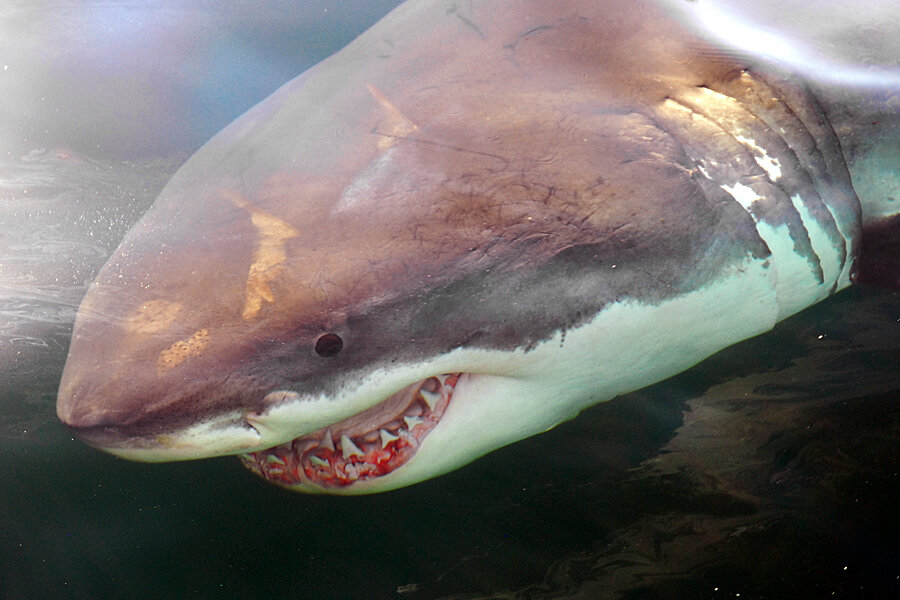Not just any ol' sharks off New York shores, but a boom of great whites
Loading...
| New York
New York and New Jersey have a robust summer beach tradition, what with their raucous ocean boardwalks, early-era roller coasters, and Coney Island hot dogs. You can even surf on some beaches along the Long Island coast or the Jersey Shore.
But more and more along the northeastern Atlantic shores, that sharp-toothed creature of mythic pop-cultural lore, the great white shark, has been side-swinging its way through the still-chilly waters. This past week, at least three great whites have been spotted not too far from the urban carnivals just getting under way on area beaches – almost on cue, too, since two new studies have just revealed the numbers of these iconic ocean predators are surging off both of America's coasts.
On Sunday, Steve Fernandez, a native of Breezy Point, in the borough of Queens, was with his buddies on one of their many fishing expeditions when they hooked an 80-pound baby great white less than a mile off Rockaway Beach, where thousands of urban beach-goers walked along its boardwalk and lay in the sand, some braving the cold early-summer waters.
“It was humbling that it was, in my opinion, the baddest fish in the ocean and we saw it a mile away from where everybody swims,” said Mr. Fernandez, an insurance salesman who moonlights with a chartered fishing boat on weekends. About an hour before hooking the little guy – which the fisherman tagged and released, in accordance with fishing regulations – the Queens crew had seen a 900-pound, 10-foot great white mama circle their boat twice.
“As soon as we saw it, there’s no mistaking it. It’s basically a miniature version of the shark you see in the movie ‘Jaws,' ” he told the New York Post.
A day earlier, Steven Clark and a group of friends were fishing off 28-Mile Wreck, the site of World War II shipwreck off New Jersey's Cape May, when a 16-foot female chomped at their bag of fishing chum – a heart-stopping experience the crew was able to capture on video. "We were worried that it was going to harm the engine,” Mr. Clark, an Avalon, N.J., resident, told the Philadelphia NBC affiliate. “It started to mouth it, but it wasn't actually biting down. I think it was just feeling it. It was just cool because she stayed around the boat for so long and really let us look at her."
And on Monday, a Cape Cod fisherman videoed an enormous 18-foot great white circling his boat, posting the six-minute clip to FaceBook.
These East Coast sightings bolster a study by National Oceanic and Atmospheric Administration, published in the June issue of the journal PLOS ONE, that concluded that more great whites are patrolling the North Atlantic shores.
The surge in great white numbers can be attributed to federal and state conservation efforts put in place in the 1990s, laws that protected both the predators and their favorite prey, ocean seals, researchers say.
"If something is wrong with the largest, most powerful group in the sea, then something is wrong with the sea, so it's a relief to find they're in good shape," said George Burgess, director of the Florida Program for Shark Research, to Discovery News.
Mr. Burgess also took part in another study that found about 2,400 great white sharks off the coast of central California, or about 10 times more than a 2011 study, which estimated only 219 predators in the area.
"For once we're getting some good news," he told National Geographic. "[White shark] numbers are going up, and [great whites are] probably in a better situation than we've seen them in our lifetimes."
And, yes, more sharks could mean more attacks at beaches – although such attacks remain more rare than getting struck by lightning. There were 72 unprovoked shark attacks worldwide in 2013, including 10 fatalities, according to the International Shark Attack File at the Florida Museum of Natural History. The US, with its thousands of miles of coastline, had the most attacks, 47, and one fatality, in Hawaii. Florida registers the most attacks.
But those seeing the sharks on the East Coast this week remain breathless at the “Jaws” sightings.
“I am still in awe 24 hours after witnessing such a spectacle,” wrote Tyler Macallister, captain of the fishing boat that encountered the great white off Cape Cod, on his FaceBook page. “Unfortunately the video does not do justice to the size and magnificence of this animal. You can really observe the calmness and presence as she investigated me and the boat. The shark stayed with us for 10 minutes, at which time she seemed to lose interest and then sink slowly away.”








